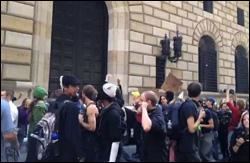By Pam Martens and Russ Martens: December 19, 2019 ~
When it comes to Wall Street’s mindset, the thinking is that it’s legal if you can get away with it. That mindset seems to have captured the Federal Reserve Bank of New York which secretly pumped trillions of dollars into insolvent banks in violation of its statutory mandate during the financial crisis; is alleged to have fired a bank examiner for refusing to alter her negative examination of Goldman Sachs; and failed to investigate a litany of crimes to which it was made aware. (See U.S. Senate Tries Public Shaming of New York Fed President Dudley.)
One of the crimes that the New York Fed failed to bring to the attention of U.S. law enforcement was mega banks cheating on the borrowing rates that they were reporting as their London InterBank Offered Rate or Libor, a benchmark interest rate used globally to settle derivative trades and used as a reference rate to set mortgage rates, credit card rates, student loans and other consumer loans.
The largest banks on Wall Street have collectively paid billions of dollars to settle charges around the globe that they rigged Libor rates to benefit their own trading positions or, in some cases, to make themselves look healthier than they actually were by submitting a Libor rate that was below their true cost of borrowing from other banks.
For example, on June 27, 2012 the U.S. Department of Justice fined the U.K. trading house and bank, Barclays, $160 million for submitting false Libor borrowing costs.
According to the Justice Department, “between approximately August 2007 and January 2009, in response to initial and ongoing press speculation that Barclays’s high U.S. Dollar LIBOR submissions at the time might reflect liquidity problems at Barclays, members of Barclays management directed that Barclays’s Dollar LIBOR submissions be lowered. This management instruction often resulted in Barclays’s submission of false rates that did not reflect its perceived cost of obtaining interbank funds.”
On December 12, 2012, the U.S. Department of Justice criminally charged Tom Hayes, a former UBS and Citigroup trader, in the Libor matter on charges that included “the publication of manipulated interest rate information in New York, New York.” Hayes is currently serving an 11-year prison sentence.
Against that backdrop, consider what happened on September 17 of this year and every business day since then.
On September 17, the interest rate on overnight loans in the repurchase agreement market (repo loans) spiked from the typical 2 percent to 10 percent. The U.S. repo market is where banks, hedge funds and mutual funds make overnight loans to one another against good collateral such as U.S. Treasury securities. The large spike in rates suggested to many on Wall Street that the mega banks on Wall Street were backing away from lending to one or more financial institutions or hedge funds out of fear over their creditworthiness. (See “Intra-day Bankruptcy”: A 2008 Email from the Fed Provides Insight into Today’s Overnight Repo Scare.)
But instead of allowing the free market to engage in further price discovery in the overnight loan market and allow a free market to determine the true cost of borrowing for specific banks, the New York Fed instead jumped into the market on September 17 and proceeded to flood the market with hundreds of billions of dollars each week in supercheap loans, thus artificially manipulating and obfuscating the true borrowing cost in this market.
The New York Fed has intervened in this market every single business day since September 17. Last Thursday, the New York Fed announced that it has no plans to allow this market to function on its own. (See New York Fed Plans to Throw $2.93 Trillion at Wall Street’s Trading Houses Over Next Month as New York Times Remains Silent.)
This morning, the New York Fed loaned Wall Street trading houses, which it will not name, $26.26 billion in an overnight loan at 1.55 percent – 8.45 percent away from where this market wanted to trade on September 17. Also this morning, the New York Fed made a 14-day loan of $31.269 billion into this market at an interest rate of 1.57 percent.
Despite the New York Fed artificially manipulating interest rates in a key market in New York, Congress has yet to hold a public hearing dedicated solely to the matter. On December 5, however, the House Financial Services Committee held a hearing with U.S. Treasury Secretary Steve Mnuchin as the sole witness. Mnuchin also serves as the head of the Financial Stability Oversight Council (F-SOC) which is supposed to be closely monitoring any red flags that would impact financial stability in the U.S.
Mnuchin was repeatedly questioned by members of the Committee on what is happening in the repo market. Congressman French Hill (R-Arkansas) cut to the chase: “I think the concern is that the New York Fed is not supporting the repo market. They are the repo market. I think that’s the challenge. And we don’t see the bank reserves that are more than adequate – billions more than needed, on JPMorgan, for example, $120 billion in daily cash held at the Fed on a $60 billion cash requirement, and yet they’re not entering that repo market.”


